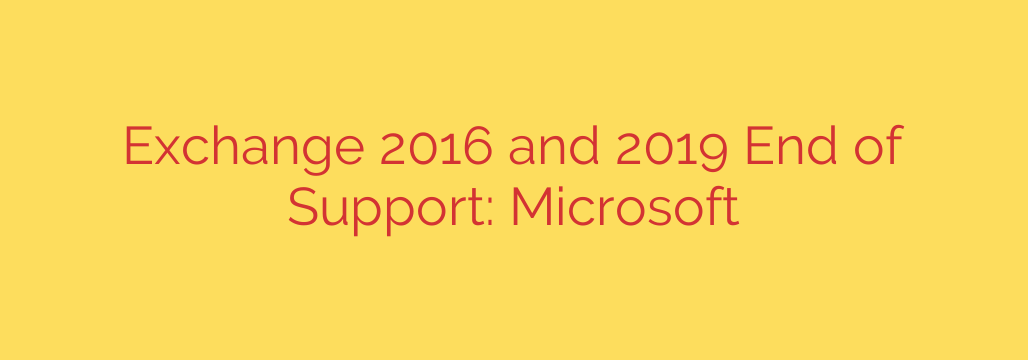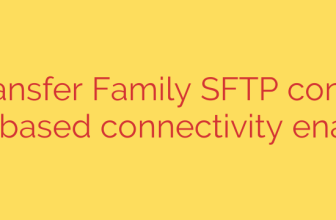
Exchange Server 2016 & 2019 End of Life: A Crucial Deadline Approaches
A critical deadline is on the horizon for organizations running Microsoft Exchange Server 2016 and 2019. On October 14, 2025, both of these widely used mail server platforms will reach their end of support, also known as “end of life” (EOL). This isn’t just a minor update notification; it’s a significant event that demands immediate attention and strategic planning.
Continuing to run on-premises Exchange servers after this date exposes your organization to serious security, compliance, and operational risks. The clock is ticking, and now is the time to create a clear migration plan to protect your business communications.
Understanding the Impact of “End of Support”
When a product reaches its end of support, it means the developer will no longer provide crucial updates or assistance. For Exchange Server 2016 and 2019, the consequences after October 14, 2025, are severe:
- No More Security Updates: This is the most critical risk. Cybercriminals actively search for and exploit vulnerabilities in unsupported software. Without new security patches, your Exchange server will become an easy and attractive target for data breaches, ransomware attacks, and other malicious activities.
- No Bug Fixes or Technical Support: Any new bugs or performance issues that arise will not be fixed. If your server experiences an outage or a critical failure, you will be on your own to resolve it, leading to extended downtime and potential data loss.
- Compliance and Regulatory Failures: Many industries are governed by regulations like HIPAA, GDPR, and SOX, which mandate that sensitive data be stored on secure, supported systems. Operating an EOL server can result in non-compliance, leading to failed audits, hefty fines, and damage to your reputation.
Essentially, running an unsupported Exchange server is like leaving the front door of your business unlocked. It’s not a matter of if a security incident will happen, but when.
Your Strategic Options: What to Do Before the 2025 Deadline
Waiting until the last minute is not a viable strategy. A server migration is a complex project that requires careful planning and execution. Fortunately, you have clear paths forward to ensure a secure and modern email infrastructure.
Option 1: Migrate to Exchange Online (Microsoft 365)
For the vast majority of organizations, migrating to the cloud-based Exchange Online is the most logical and secure solution. This path effectively outsources the management, maintenance, and security of your email platform, allowing your IT team to focus on more strategic initiatives.
Key benefits of migrating to Exchange Online include:
- Enhanced Security: Benefit from a platform that is constantly updated with advanced threat protection, anti-malware, and anti-spam filters.
- Guaranteed Uptime and Reliability: A financially-backed service level agreement (SLA) ensures your email is always available.
- Reduced Administrative Overhead: Eliminate the need for server hardware maintenance, patching, and manual updates.
- Scalability and Flexibility: Easily scale your email services up or down based on business needs and benefit from deep integration with the entire Microsoft 365 ecosystem (Teams, SharePoint, OneDrive).
A hybrid configuration can serve as an interim step, allowing you to migrate mailboxes in a phased, controlled manner while maintaining a seamless user experience.
Option 2: Upgrade to a Newer On-Premises Exchange Server
Some organizations have specific regulatory or operational requirements that necessitate an on-premises mail server. If this applies to your business, your path is to migrate to the next version of Exchange Server, known as the Subscription Edition (SE).
This process involves:
- Planning for a Full Migration: This is not an in-place upgrade. It requires setting up new servers and migrating mailboxes, public folders, and mail flow configurations.
- Investing in New Hardware: The new version of Exchange Server will have different hardware and operating system requirements.
- Committing to Ongoing Maintenance: You will remain responsible for all future patching, security updates, and hardware management.
While a valid option for specific use cases, this path requires a significant investment in time, resources, and expertise compared to a cloud migration.
Your Action Plan: A Step-by-Step Guide to a Smooth Transition
The October 14, 2025, deadline is firm. To avoid a last-minute crisis, follow these steps to begin your migration journey today.
- Assess Your Current Environment: Take a full inventory of your Exchange 2016/2019 servers. Understand your mail flow, third-party integrations, and overall architecture.
- Evaluate Your Business Needs: Determine which path—Exchange Online or a newer on-premises version—best aligns with your long-term business goals, security posture, and budget.
- Create a Detailed Migration Plan: Outline every step of the project, including timelines, resource allocation, user communication, and post-migration testing. Don’t underestimate the complexity of the process.
- Start the Migration Process Early: Begin your migration well in advance of the deadline. This provides a buffer to address any unexpected challenges without the pressure of an impending EOL date.
- Decommission Your Old Servers: Once the migration is complete and verified, it is crucial to properly and securely decommission your old Exchange 2016 and 2019 servers to eliminate them as a security risk.
Don’t let the 2025 deadline catch you unprepared. Proactive planning is the key to a secure, seamless, and successful transition for your organization’s most critical communication tool.
Source: https://www.bleepingcomputer.com/news/microsoft/microsoft-exchange-2016-and-2019-have-reached-end-of-support/







